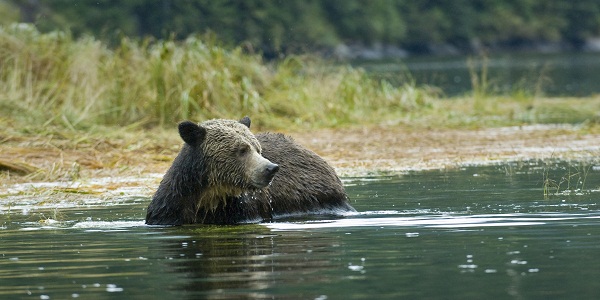The Great Bear Rainforest needs protection on land and sea
posted by: Administrator, February 28, 2012 at 4pm
By Eduardo Sousa (Greenpeace), Jens Wieting (Sierra Club BC) and Valerie Langer (ForestEthics)
The Great Bear Rainforest encompasses 6.4 million hectares of temperate rainforest, salmon rivers, archipelagos of verdant islands and hundreds of rich estuaries where the ocean and forest meet. It is an ocean-influenced forest, or maybe you could call it a forest-influenced ocean. It’s both and, like the Amazon and the Great Barrier Reef, it is known as an internationally significant ecosystem. Ensuring that enough habitat for animals and plants is protected and that logging within nature’s limits supports community well-being is one of the most important things we can do to make sure that the Great Bear Rainforest is sustained for future generations. That’s why Greenpeace, Sierra Club BC and ForestEthics are calling on the provincial government to make 70 per cent of the natural old-growth forest off-limits to logging by fully implementing the Great Bear Rainforest Agreements.
Too much logging causes a steady and certain erosion of forest health and species survival. And an oil spill from one of the 250 supertankers per year that would transport corrosive crude oil from the proposed Enbridge pipeline would be a sudden catastrophe. The intimate relationship between the ocean and the forest would be dealt a devastating blow. Unsustainable logging poses the greatest danger to the terrestrial ecosystems of the Great Bear Rainforest. Enbridge’s proposed Northern Gateway Pipeline threatens its marine counterpart. As we call on the provincial government to protect the land, we need to make sure our coast is safe, too.
When you look at a map of the Great Bear Rainforest you see how rivers run like veins from the coast mountains down valleys that merge with the saltwater fjords that carve deep into the forest. It’s at these meeting points, called estuaries, where you’ll find some of the most biologically rich environments in the world. Birds, bears and wolves from deep in the forest feed on the fish, shellfish and plants that grow here. After spending years in the open ocean, many salmon species spawn in the estuaries, while others travel further into the forest to lay their eggs.

Photo: Grizzly Bear fishing, Muscle Estuary. Credit: Andrew Wright.
The proposed pipeline would run from Alberta’s tar sands to Kitimat, B.C., crossing many salmon rivers and streams on the way. There, some of the world’s largest supertankers (with a carrying capacity of 2 million barrels of oil) would load up with the unrefined crude before navigating narrow and often stormy channels through the Great Bear Rainforest on the way to Asia. These supertankers would pass Princess Royal Island, the stronghold of the rare white Spirit Bear (a genetic variant of the black bear), as they churn through waters that are home to orcas, humpbacks, fin whales and Steller sea lions. The question of an oil spill here is not a matter of if, but when. And while the impacts would be devastating for ocean life, the deadly reverberations would also be felt deep into the forest.
Over 100 First Nations and 80 per cent of British Columbians oppose the pipeline project. The Union of British Columbia Municipalities has opposed both Enbridge’s project and oil tanker traffic on the B.C. coast. The provincial government has said it’s waiting to hear the recommendations of a joint review panel that is looking at the merits and risks of the proposed pipeline before it takes a position. How the province will meet its commitment to protect the Great Bear Rainforest without actively opposing Enbridge’s Northern Gateway project remains a huge question.
What’s for certain, however, is that the provincial government has an opportunity to ensure that enough forest is protected from logging right now. The ecosystems, communities and economies of the Great Bear Rainforest are endangered by the pipeline proposal and supertankers, as well as the fact that only half of the forest is protected from logging. In contrast to the oil and gas industry, a group of logging companies operating in the region is working to adapt their businesses in support of conservation targets recommended by scientists. Premier Christy Clark can also demonstrate her government’s commitment to protecting the Great Bear Rainforest by taking immediate steps to make sure the Great Bear Rainforest Agreements are fully implemented, and the forests properly protected, before the next election. So that British Columbians can rest assured that one of the last rainforests of its kind in the world stands a chance of surviving.
Join the call to Take It Taller for the Great Bear Rainforest. Take action today!